Alfa Romeo MiTo 2015 Owner's Manual
Manufacturer: ALFA ROMEO, Model Year: 2015, Model line: MiTo, Model: Alfa Romeo MiTo 2015Pages: 280, PDF Size: 8.52 MB
Page 191 of 280
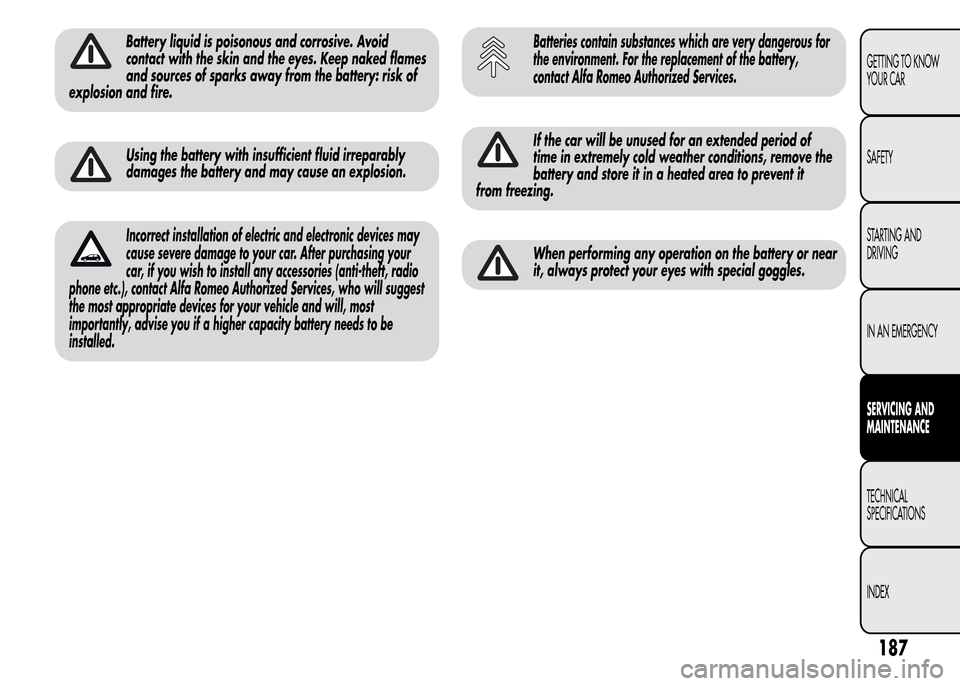
Battery liquid is poisonous and corrosive. Avoid
contact with the skin and the eyes. Keep naked flames
and sources of sparks away from the battery: risk of
explosion and fire.
Using the battery with insufficient fluid irreparably
damages the battery and may cause an explosion.
Incorrect installation of electric and electronic devices may
cause severe damage to your car. After purchasing your
car, if you wish to install any accessories (anti-theft, radio
phone etc.), contact Alfa Romeo Authorized Services, who will suggest
the most appropriate devices for your vehicle and will, most
importantly, advise you if a higher capacity battery needs to be
installed.
Batteries contain substances which are very dangerous for
the environment. For the replacement of the battery,
contact Alfa Romeo Authorized Services.
If the car will be unused for an extended period of
time in extremely cold weather conditions, remove the
battery and store it in a heated area to prevent it
from freezing.
When performing any operation on the battery or near
it, always protect your eyes with special goggles.
187
GETTING TO KNOW
YOUR CAR
SAFETY
STARTING AND
DRIVING
IN AN EMERGENCY
SERVICING AND
MAINTENANCE
TECHNICAL
SPECIFICATIONS
INDEX
Page 192 of 280
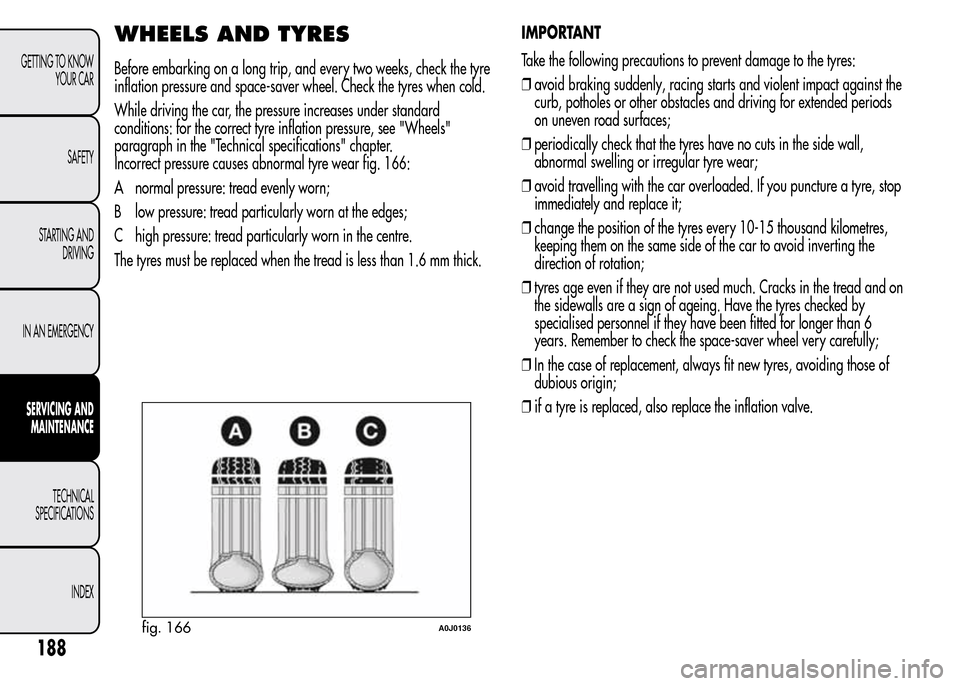
WHEELS AND TYRES
Before embarking on a long trip, and every two weeks, check the tyre
inflation pressure and space-saver wheel. Check the tyres when cold.
While driving the car, the pressure increases under standard
conditions: for the correct tyre inflation pressure, see "Wheels"
paragraph in the "Technical specifications" chapter.
Incorrect pressure causes abnormal tyre wear fig. 166:
A normal pressure: tread evenly worn;
B low pressure: tread particularly worn at the edges;
C high pressure: tread particularly worn in the centre.
The tyres must be replaced when the tread is less than 1.6 mm thick.IMPORTANT
Take the following precautions to prevent damage to the tyres:
❒avoid braking suddenly, racing starts and violent impact against the
curb, potholes or other obstacles and driving for extended periods
on uneven road surfaces;
❒periodically check that the tyres have no cuts in the side wall,
abnormal swelling or irregular tyre wear;
❒avoid travelling with the car overloaded. If you puncture a tyre, stop
immediately and replace it;
❒change the position of the tyres every 10-15 thousand kilometres,
keeping them on the same side of the car to avoid inverting the
direction of rotation;
❒tyres age even if they are not used much. Cracks in the tread and on
the sidewalls are a sign of ageing. Have the tyres checked by
specialised personnel if they have been fitted for longer than 6
years. Remember to check the space-saver wheel very carefully;
❒In the case of replacement, always fit new tyres, avoiding those of
dubious origin;
❒if a tyre is replaced, also replace the inflation valve.
fig. 166A0J0136
188
GETTING TO KNOW
YOUR CAR
SAFETY
STARTING AND
DRIVING
IN AN EMERGENCY
SERVICING AND
MAINTENANCE
TECHNICAL
SPECIFICATIONS
INDEX
Page 193 of 280
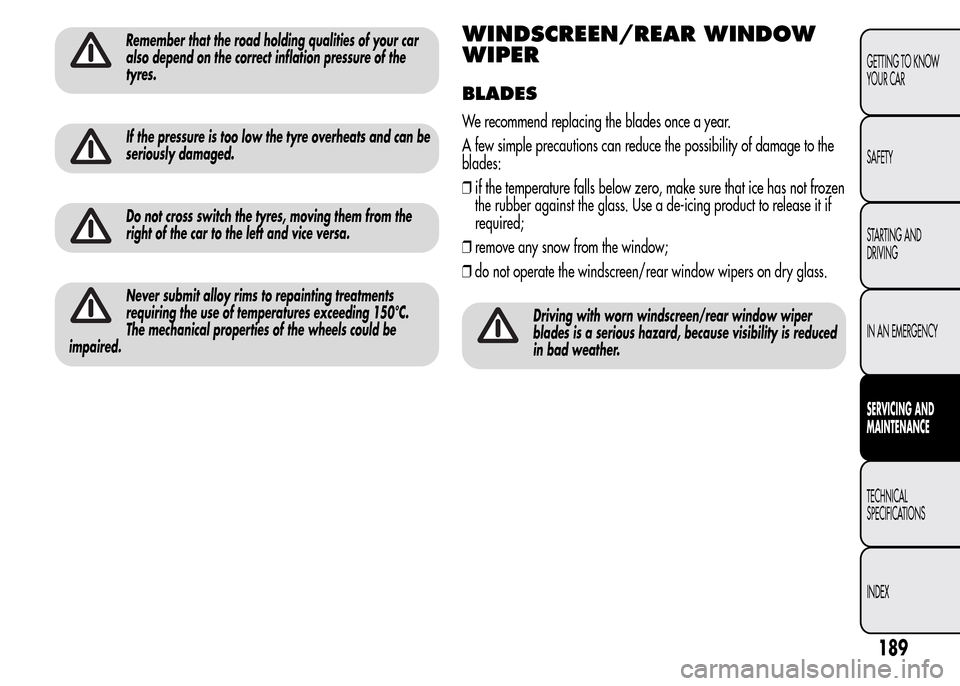
Remember that the road holding qualities of your car
also depend on the correct inflation pressure of the
tyres.
If the pressure is too low the tyre overheats and can be
seriously damaged.
Do not cross switch the tyres, moving them from the
right of the car to the left and vice versa.
Never submit alloy rims to repainting treatments
requiring the use of temperatures exceeding 150°C.
The mechanical properties of the wheels could be
impaired.
WINDSCREEN/REAR WINDOW
WIPER
BLADES
We recommend replacing the blades once a year.
A few simple precautions can reduce the possibility of damage to the
blades:
❒if the temperature falls below zero, make sure that ice has not frozen
the rubber against the glass. Use a de-icing product to release it if
required;
❒remove any snow from the window;
❒do not operate the windscreen/rear window wipers on dry glass.
Driving with worn windscreen/rear window wiper
blades is a serious hazard, because visibility is reduced
in bad weather.
189
GETTING TO KNOW
YOUR CAR
SAFETY
STARTING AND
DRIVING
IN AN EMERGENCY
SERVICING AND
MAINTENANCE
TECHNICAL
SPECIFICATIONS
INDEX
Page 194 of 280
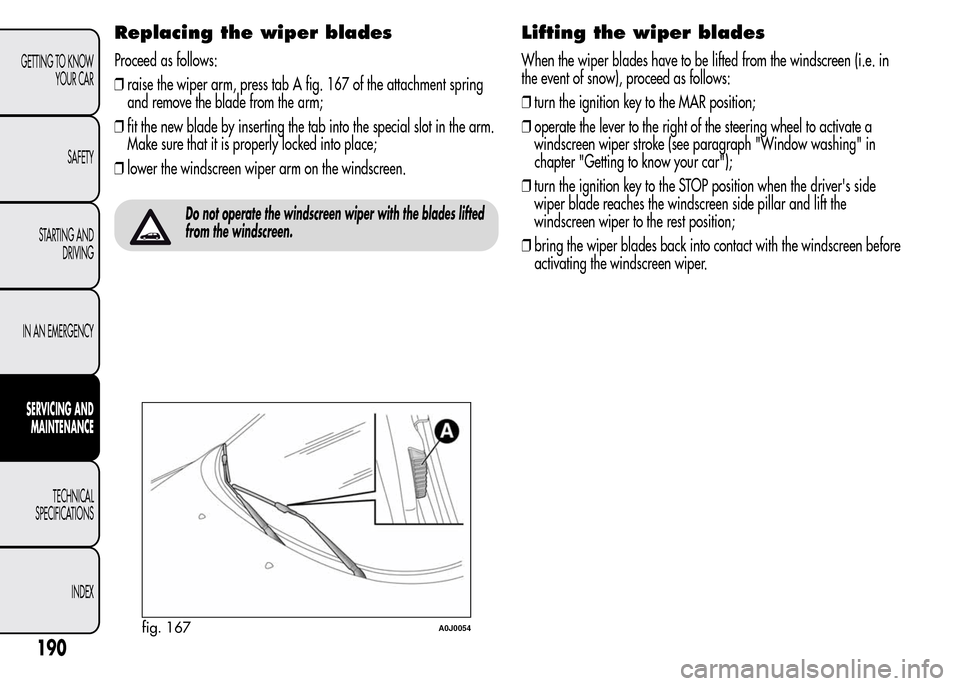
Replacing the wiper blades
Proceed as follows:
❒raise the wiper arm, press tab A fig. 167 of the attachment spring
and remove the blade from the arm;
❒fit the new blade by inserting the tab into the special slot in the arm.
Make sure that it is properly locked into place;
❒lower the windscreen wiper arm on the windscreen.
Do not operate the windscreen wiper with the blades lifted
from the windscreen.
Lifting the wiper blades
When the wiper blades have to be lifted from the windscreen (i.e. in
the event of snow), proceed as follows:
❒turn the ignition key to the MAR position;
❒operate the lever to the right of the steering wheel to activate a
windscreen wiper stroke (see paragraph "Window washing" in
chapter "Getting to know your car");
❒turn the ignition key to the STOP position when the driver's side
wiper blade reaches the windscreen side pillar and lift the
windscreen wiper to the rest position;
❒bring the wiper blades back into contact with the windscreen before
activating the windscreen wiper.
fig. 167A0J0054
190
GETTING TO KNOW
YOUR CAR
SAFETY
STARTING AND
DRIVING
IN AN EMERGENCY
SERVICING AND
MAINTENANCE
TECHNICAL
SPECIFICATIONS
INDEX
Page 195 of 280
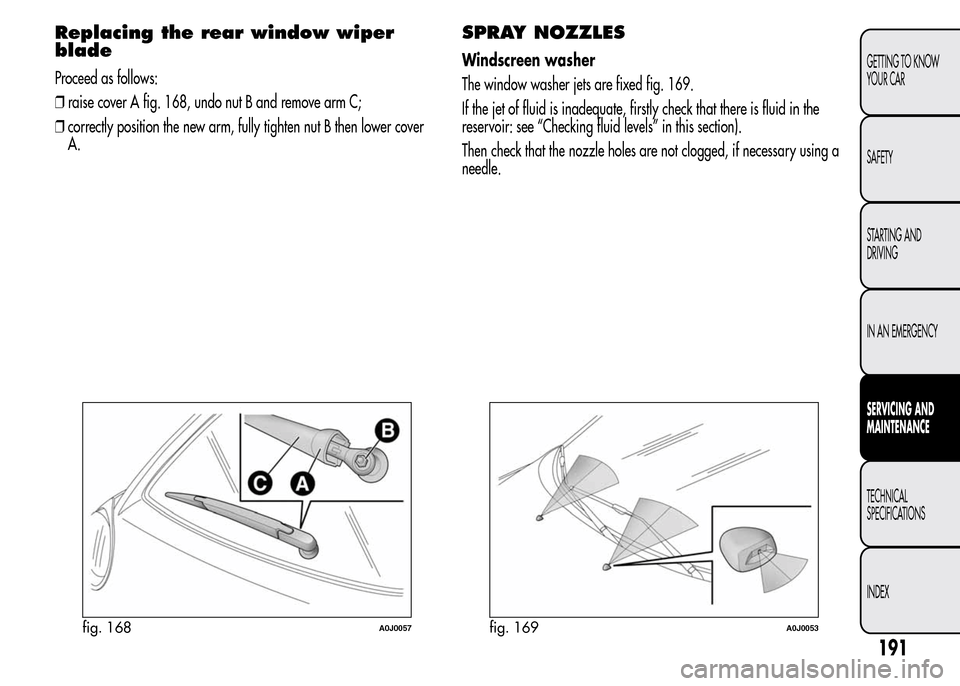
Replacing the rear window wiper
blade
Proceed as follows:
❒raise cover A fig. 168, undo nut B and remove arm C;
❒correctly position the new arm, fully tighten nut B then lower cover
A.
SPRAY NOZZLES
Windscreen washer
The window washer jets are fixed fig. 169.
If the jet of fluid is inadequate, firstly check that there is fluid in the
reservoir: see “Checking fluid levels” in this section).
Then check that the nozzle holes are not clogged, if necessary using a
needle.
fig. 168A0J0057fig. 169A0J0053
191
GETTING TO KNOW
YOUR CAR
SAFETY
STARTING AND
DRIVING
IN AN EMERGENCY
SERVICING AND
MAINTENANCE
TECHNICAL
SPECIFICATIONS
INDEX
Page 196 of 280
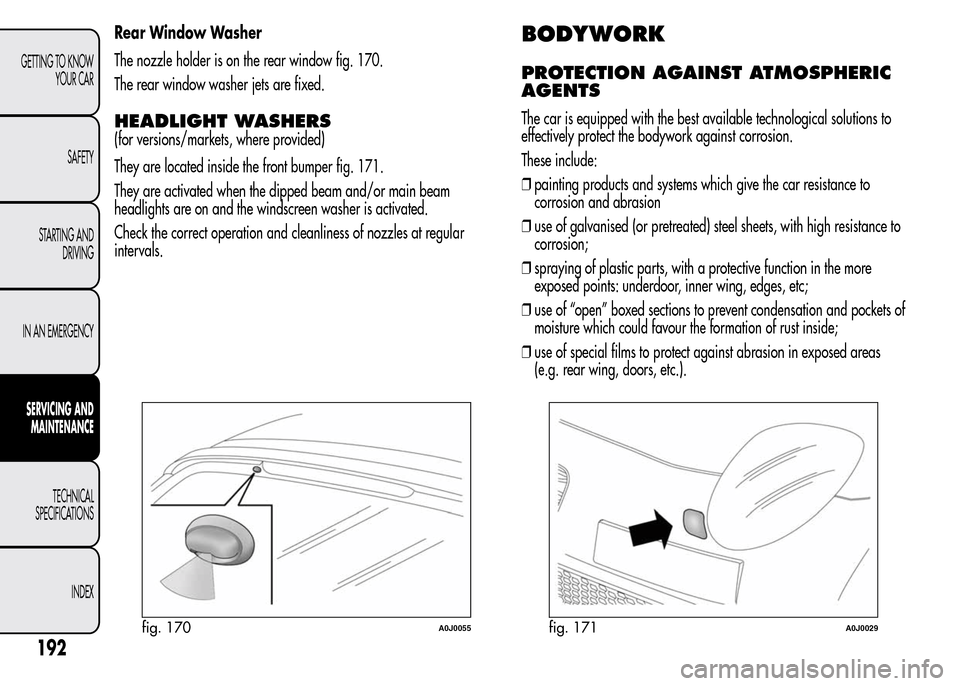
Rear Window Washer
The nozzle holder is on the rear window fig. 170.
The rear window washer jets are fixed.
HEADLIGHT WASHERS
(for versions/markets, where provided)
They are located inside the front bumper fig. 171.
They are activated when the dipped beam and/or main beam
headlights are on and the windscreen washer is activated.
Check the correct operation and cleanliness of nozzles at regular
intervals.
BODYWORK
PROTECTION AGAINST ATMOSPHERIC
AGENTS
The car is equipped with the best available technological solutions to
effectively protect the bodywork against corrosion.
These include:
❒painting products and systems which give the car resistance to
corrosion and abrasion
❒use of galvanised (or pretreated) steel sheets, with high resistance to
corrosion;
❒spraying of plastic parts, with a protective function in the more
exposed points: underdoor, inner wing, edges, etc;
❒use of “open” boxed sections to prevent condensation and pockets of
moisture which could favour the formation of rust inside;
❒use of special films to protect against abrasion in exposed areas
(e.g. rear wing, doors, etc.).
fig. 170A0J0055fig. 171A0J0029
192
GETTING TO KNOW
YOUR CAR
SAFETY
STARTING AND
DRIVING
IN AN EMERGENCY
SERVICING AND
MAINTENANCE
TECHNICAL
SPECIFICATIONS
INDEX
Page 197 of 280
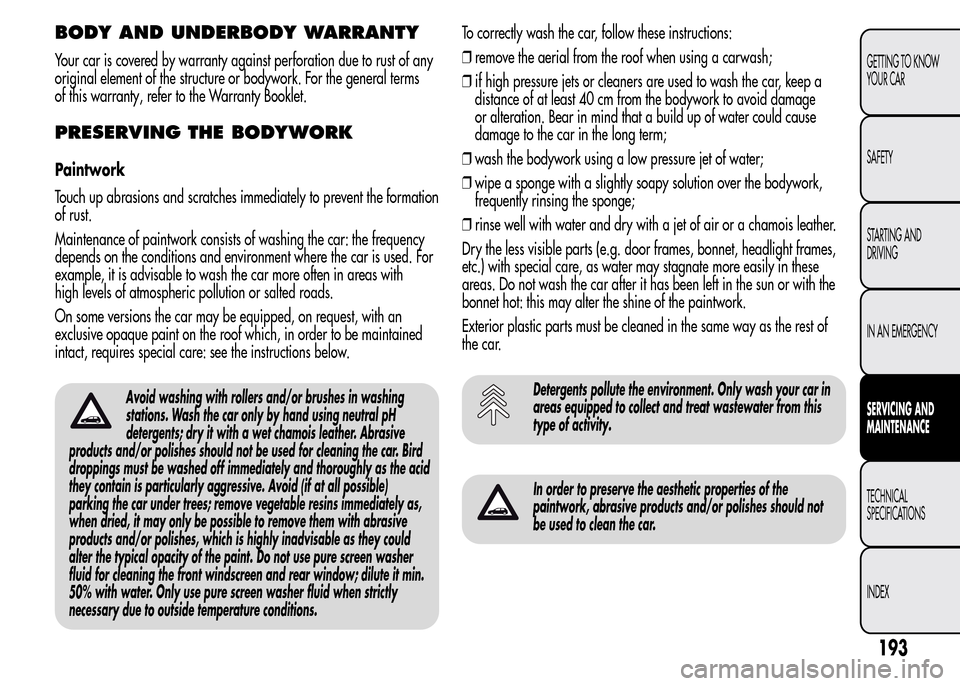
BODY AND UNDERBODY WARRANTY
Your car is covered by warranty against perforation due to rust of any
original element of the structure or bodywork. For the general terms
of this warranty, refer to the Warranty Booklet.
PRESERVING THE BODYWORK
Paintwork
Touch up abrasions and scratches immediately to prevent the formation
of rust.
Maintenance of paintwork consists of washing the car: the frequency
depends on the conditions and environment where the car is used. For
example, it is advisable to wash the car more often in areas with
high levels of atmospheric pollution or salted roads.
On some versions the car may be equipped, on request, with an
exclusive opaque paint on the roof which, in order to be maintained
intact, requires special care: see the instructions below.
Avoid washing with rollers and/or brushes in washing
stations. Wash the car only by hand using neutral pH
detergents; dry it with a wet chamois leather. Abrasive
products and/or polishes should not be used for cleaning the car. Bird
droppings must be washed off immediately and thoroughly as the acid
they contain is particularly aggressive. Avoid (if at all possible)
parking the car under trees; remove vegetable resins immediately as,
when dried, it may only be possible to remove them with abrasive
products and/or polishes, which is highly inadvisable as they could
alter the typical opacity of the paint. Do not use pure screen washer
fluid for cleaning the front windscreen and rear window; dilute it min.
50% with water. Only use pure screen washer fluid when strictly
necessary due to outside temperature conditions.
To correctly wash the car, follow these instructions:
❒remove the aerial from the roof when using a carwash;
❒if high pressure jets or cleaners are used to wash the car, keep a
distance of at least 40 cm from the bodywork to avoid damage
or alteration. Bear in mind that a build up of water could cause
damage to the car in the long term;
❒wash the bodywork using a low pressure jet of water;
❒wipe a sponge with a slightly soapy solution over the bodywork,
frequently rinsing the sponge;
❒rinse well with water and dry with a jet of air or a chamois leather.
Dry the less visible parts (e.g. door frames, bonnet, headlight frames,
etc.) with special care, as water may stagnate more easily in these
areas. Do not wash the car after it has been left in the sun or with the
bonnet hot: this may alter the shine of the paintwork.
Exterior plastic parts must be cleaned in the same way as the rest of
the car.
Detergents pollute the environment. Only wash your car in
areas equipped to collect and treat wastewater from this
type of activity.
In order to preserve the aesthetic properties of the
paintwork, abrasive products and/or polishes should not
be used to clean the car.
193
GETTING TO KNOW
YOUR CAR
SAFETY
STARTING AND
DRIVING
IN AN EMERGENCY
SERVICING AND
MAINTENANCE
TECHNICAL
SPECIFICATIONS
INDEX
Page 198 of 280
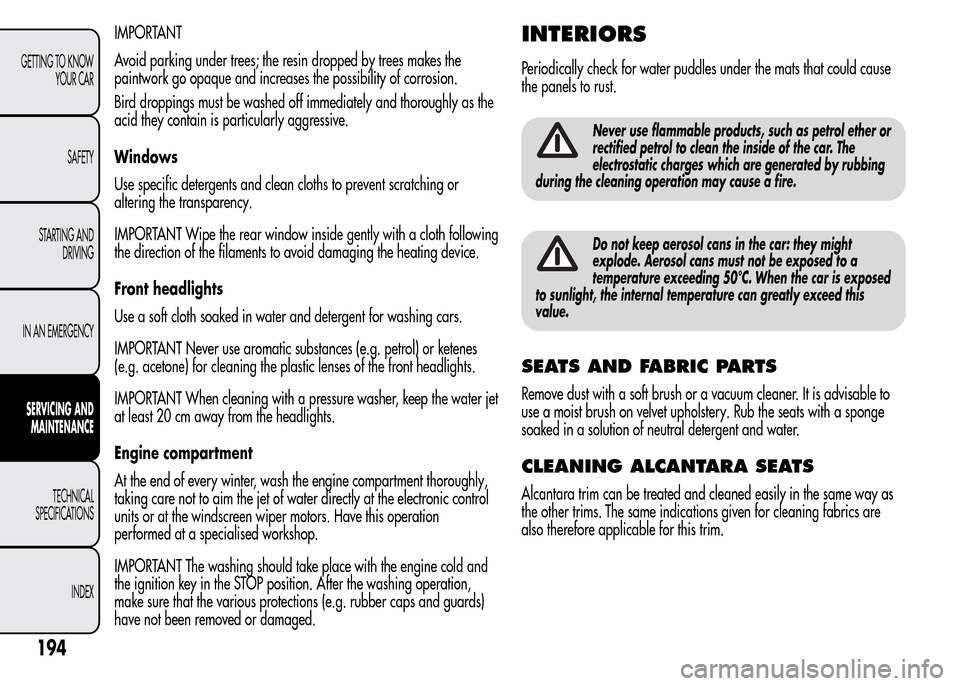
IMPORTANT
Avoid parking under trees; the resin dropped by trees makes the
paintwork go opaque and increases the possibility of corrosion.
Bird droppings must be washed off immediately and thoroughly as the
acid they contain is particularly aggressive.
Windows
Use specific detergents and clean cloths to prevent scratching or
altering the transparency.
IMPORTANT Wipe the rear window inside gently with a cloth following
the direction of the filaments to avoid damaging the heating device.
Front headlights
Use a soft cloth soaked in water and detergent for washing cars.
IMPORTANT Never use aromatic substances (e.g. petrol) or ketenes
(e.g. acetone) for cleaning the plastic lenses of the front headlights.
IMPORTANT When cleaning with a pressure washer, keep the water jet
at least 20 cm away from the headlights.
Engine compartment
At the end of every winter, wash the engine compartment thoroughly,
taking care not to aim the jet of water directly at the electronic control
units or at the windscreen wiper motors. Have this operation
performed at a specialised workshop.
IMPORTANT The washing should take place with the engine cold and
the ignition key in the STOP position. After the washing operation,
make sure that the various protections (e.g. rubber caps and guards)
have not been removed or damaged.INTERIORS
Periodically check for water puddles under the mats that could cause
the panels to rust.
Never use flammable products, such as petrol ether or
rectified petrol to clean the inside of the car. The
electrostatic charges which are generated by rubbing
during the cleaning operation may cause a fire.
Do not keep aerosol cans in the car: they might
explode. Aerosol cans must not be exposed to a
temperature exceeding 50°C. When the car is exposed
to sunlight, the internal temperature can greatly exceed this
value.
SEATS AND FABRIC PARTS
Remove dust with a soft brush or a vacuum cleaner. It is advisable to
use a moist brush on velvet upholstery. Rub the seats with a sponge
soaked in a solution of neutral detergent and water.
CLEANING ALCANTARA SEATS
Alcantara trim can be treated and cleaned easily in the same way as
the other trims. The same indications given for cleaning fabrics are
also therefore applicable for this trim.
194
GETTING TO KNOW
YOUR CAR
SAFETY
STARTING AND
DRIVING
IN AN EMERGENCY
SERVICING AND
MAINTENANCE
TECHNICAL
SPECIFICATIONS
INDEX
Page 199 of 280
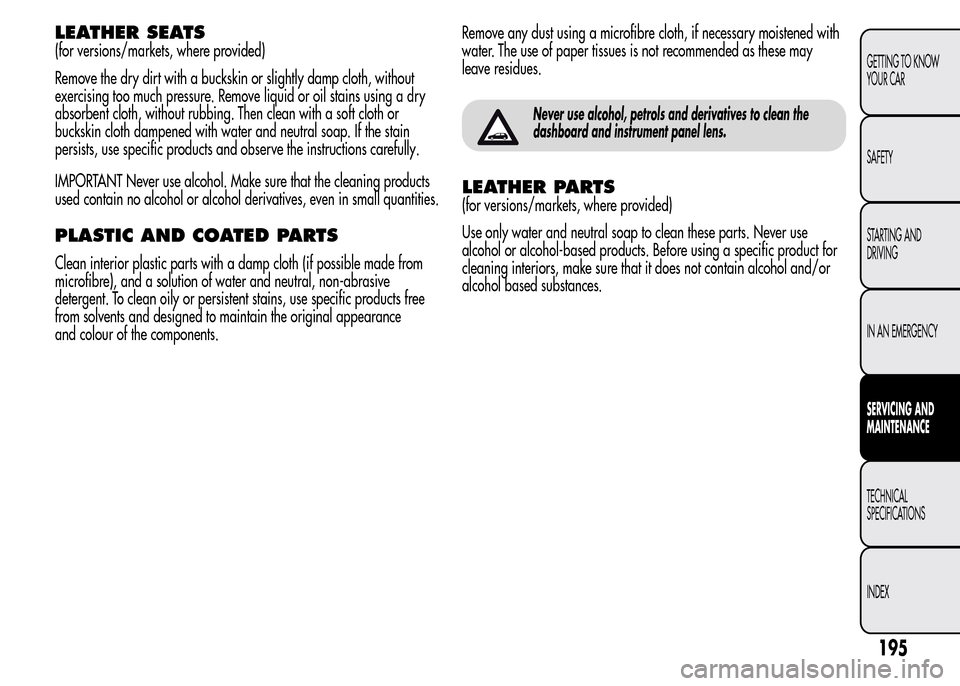
LEATHER SEATS
(for versions/markets, where provided)
Remove the dry dirt with a buckskin or slightly damp cloth, without
exercising too much pressure. Remove liquid or oil stains using a dry
absorbent cloth, without rubbing. Then clean with a soft cloth or
buckskin cloth dampened with water and neutral soap. If the stain
persists, use specific products and observe the instructions carefully.
IMPORTANT Never use alcohol. Make sure that the cleaning products
used contain no alcohol or alcohol derivatives, even in small quantities.
PLASTIC AND COATED PARTS
Clean interior plastic parts with a damp cloth (if possible made from
microfibre), and a solution of water and neutral, non-abrasive
detergent. To clean oily or persistent stains, use specific products free
from solvents and designed to maintain the original appearance
and colour of the components.Remove any dust using a microfibre cloth, if necessary moistened with
water. The use of paper tissues is not recommended as these may
leave residues.
Never use alcohol, petrols and derivatives to clean the
dashboard and instrument panel lens.
LEATHER PARTS
(for versions/markets, where provided)
Use only water and neutral soap to clean these parts. Never use
alcohol or alcohol-based products. Before using a specific product for
cleaning interiors, make sure that it does not contain alcohol and/or
alcohol based substances.
195
GETTING TO KNOW
YOUR CAR
SAFETY
STARTING AND
DRIVING
IN AN EMERGENCY
SERVICING AND
MAINTENANCE
TECHNICAL
SPECIFICATIONS
INDEX
Page 200 of 280
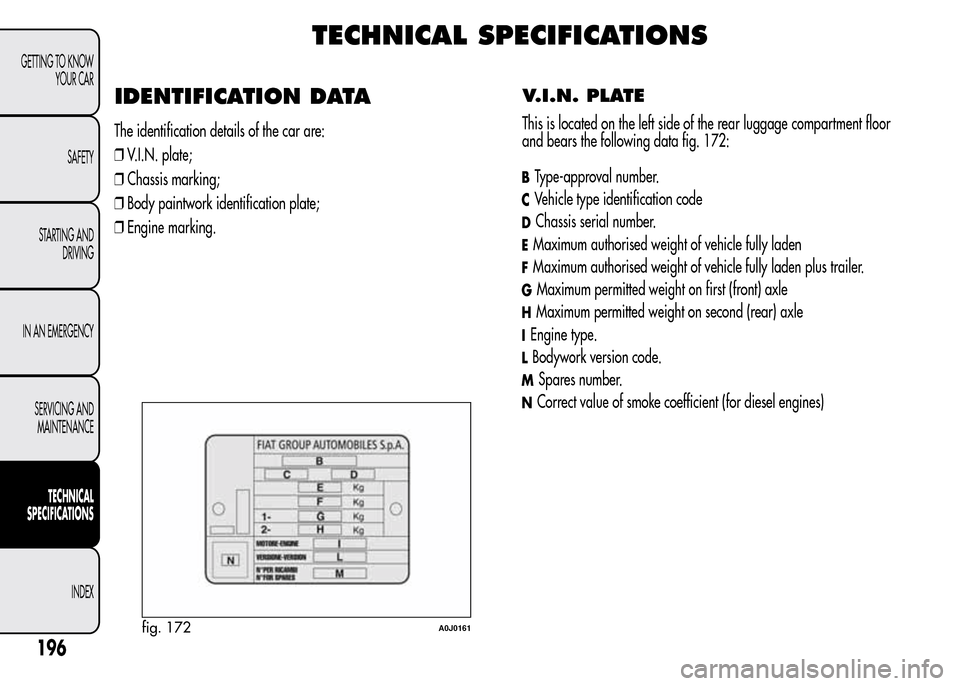
TECHNICAL SPECIFICATIONS
IDENTIFICATION DATA
The identification details of the car are:
❒V.I.N. plate;
❒Chassis marking;
❒Body paintwork identification plate;
❒Engine marking.
V.I.N. PLATE
This is located on the left side of the rear luggage compartment floor
and bears the following data fig. 172:
BType-approval number.
CVehicle type identification code
DChassis serial number.
EMaximum authorised weight of vehicle fully laden
FMaximum authorised weight of vehicle fully laden plus trailer.
GMaximum permitted weight on first (front) axle
HMaximum permitted weight on second (rear) axle
IEngine type.
LBodywork version code.
MSpares number.
NCorrect value of smoke coefficient (for diesel engines)
fig. 172A0J0161
196
GETTING TO KNOW
YOUR CAR
SAFETY
STARTING AND
DRIVING
IN AN EMERGENCY
SERVICING AND
MAINTENANCE
TECHNICAL
SPECIFICATIONS
INDEX